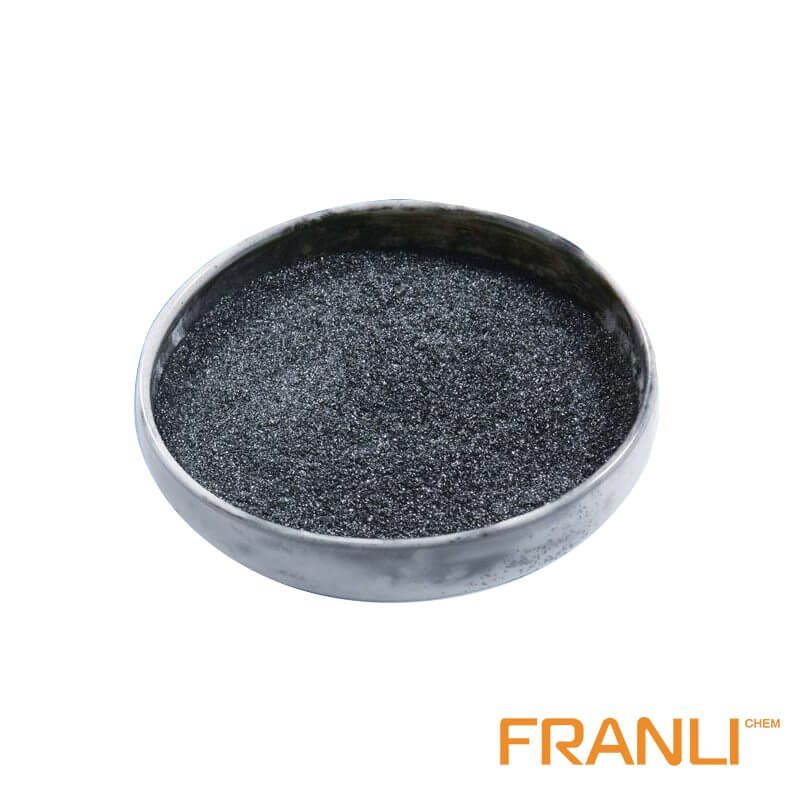

Carbon Graphite
Size
0.01mm
Carbon Content
99%min
Package
25kg small bags into ton bags or ton bags
Features
Good thermal and electrical conductivity, grey-black opaque solid
Application
For mechanical seals, battery manufacturing, anti-corrosion products, carbon graphite electrodes, etc.
Carbon graphite can be used to produce refractory materials, conductive materials, wear-resistant materials, lubricants, high-temperature sealing materials, corrosion-resistant materials, thermal insulation materials, adsorption materials, friction materials and radiation protection materials, etc. These materials are widely used in electromechanical brush and seal etc.
Request a quoteIn recent years, carbon graphite materials have emerged in the electronic technology industry. With its excellent thermal conductivity, rapid heat dissipation (convection with air), and light weight and flexibility, the carbon-graphite from Franli factory is considered to be a high-quality heat dissipation material. Replace the traditional heat dissipation materials such as copper and aluminum.

Electronic use of carbon graphite heat dissipation design
Carbon graphite is an ideal choice for heat dissipation. The heat dissipation design should be optimized from the product stacking and PCB layout, and then the software optimizes the situation to reduce power, or adjusts the battery current, combined with the temperature rise standard, and introduces carbon graphite materials. A thermal pad can be added between the shielding cover and the main heat source to conduct heat to the shielding cover as soon as possible, because the air has a very large thermal resistance; use carbon-graphite sheets to fit as flat as possible without wrinkles, otherwise it will reduce its heat dissipation capacity; When the main heat source PCB is laid out on the TOP surface, the in-mold steel sheet or magnesium alloy at the bottom of the LCD is attached with a carbon graphite sheet, which plays a role of heat dissipation/heating, which is beneficial to achieve thermal balance between the front and rear shells; the carbon graphite sheet is attached to the battery cover to dissipate heat.
For heat insulation, thicker carbon graphite sheets can be used. Thick stone diaphragms have a larger specific volume and better heat insulation effect; when using a high-definition screen, the TW temperature is too high due to the high-definition high-refresh rate LCD and the high calorific value. The carbon graphite sheet is added to the bottom position. The carbon graphite of the same grade is the same thickness as the PET/adhesive, the thicker the carbon graphite.
Heat dissipation method using carbon graphite
(1) Block the shielding heat source. The carbon-graphite heat dissipation film has a thermal conductivity that is difficult for other metals to reach in the horizontal direction, but its thermal conductivity is very low in the vertical direction. This feature is an important reason why smart electronic products choose it as a heat sink. In fact, the carbon graphite heat dissipation film plays a role in heat insulation to a certain extent here. On the one hand, it distributes the heat evenly and relieves local overheating inside the electronic product. At the same time, it spreads the heat quickly before it reaches the case, so that the user does not feel too hot.

(2) Evenly spread the heat source. Because the carbon-graphite heat dissipation film has a high horizontal thermal conductivity, it can conduct rapid heat conduction in the horizontal direction, so that the heat distribution on the entire surface in the horizontal direction is uniform, and local hot spots are eliminated.
Choice of heat-dissipating carbon graphite types
(1) The Franli factory believes that the higher the thermal conductivity of carbon graphite, the better, the higher the density, the better, the more uniform the thickness, the better, and the smaller the bending strength, the better
(2) Whether it is thermal conductivity, density, thickness uniformity, thickness selectivity are 30%~40% higher than natural carbon graphite, according to the actual structure, temperature resistance requirements, appearance color, insulation requirements to choose different thickness performance to be processed Carbon graphite; carbon graphite with different thicknesses will have different thermal resistance. The thicker it is, the more heat it can block. Combined with the selection of materials in terms of process and cost, the most cost-effective carbon graphite varieties are comprehensively selected.
With the increasing intelligence of consumer electronic products, the number and integration of electronic components required in their products are getting higher and higher, which directly leads to an increase in the power consumption of electronic products and the heat generated during operation. come bigger. In particular, the rapid development of mobile phones poses greater challenges to the heat dissipation requirements of electronic products.
Most of the traditional heat dissipation materials are metal, but due to the high metal density, high thermal expansion coefficient and low thermal conductivity, it has been difficult to meet the current requirements for efficient heat dissipation of electronic products. Carbon graphite can be chemically treated to become a heat dissipation material, and then expanded and formed at high temperature. The carbon graphite from the Franli factory can be chemically processed into a heat-dissipating material and then expanded at high temperature. Carbon graphite is currently the material with the best thermal conductivity in the world, saving a lot of metal costs for major machinery and electronic factories.



